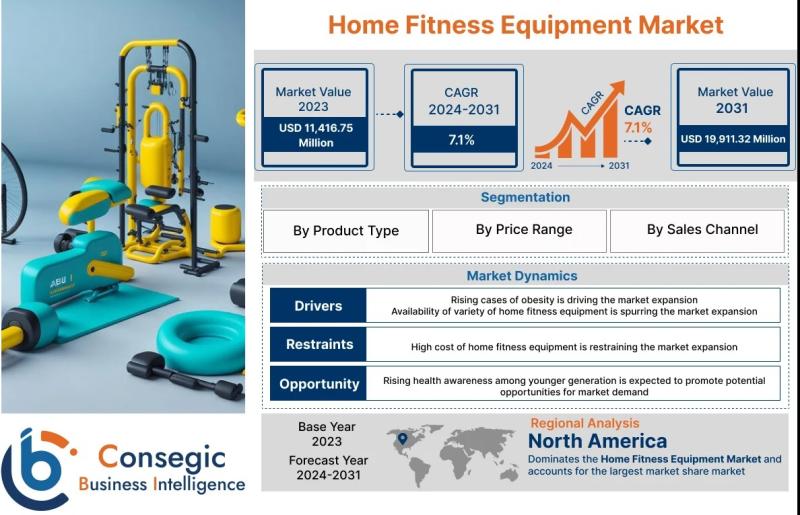
Global Home Fitness Equipment Market
“
Introduction:
The Home Fitness Equipment Market is experiencing robust growth, driven by a confluence of factors that include an increasing emphasis on personal health and wellness, advancements in fitness technology, and a shift towards more convenient workout solutions. Technological innovations, such as interactive fitness platforms, virtual reality integration, and personalized training programs, are transforming the way people exercise at home, making it more engaging and effective. The market’s growth is also fueled by a rise in disposable income in many regions, allowing consumers to invest in high-quality fitness equipment. Furthermore, the market plays a crucial role in addressing global challenges related to sedentary lifestyles and rising rates of obesity and chronic diseases. By providing accessible and convenient workout options, the Home Fitness Equipment Market empowers individuals to take control of their health and well-being. The COVID-19 pandemic further accelerated the adoption of home fitness solutions, as lockdowns and social distancing measures restricted access to traditional gyms and fitness centers. This shift in consumer behavior is expected to persist, as individuals increasingly appreciate the flexibility and convenience of working out in the comfort of their own homes. The market is continuously evolving with new products, technologies, and business models emerging to cater to diverse consumer needs and preferences. As the population ages, the demand for home fitness equipment suitable for older adults is also expected to rise, further driving market growth.
Get the full PDF sample copy of the report: (TOC, Tables and figures, and Graphs) https://www.consegicbusinessintelligence.com/request-sample/1409
Market Size:
The Home Fitness Equipment Market size is estimated to reach over USD 19,911.38 Million by 2031 from a value of USD 11,461.75 Million in 2023, growing at a CAGR of 7.1% from 2024 to 2031.
Definition of Market:
The Home Fitness Equipment Market encompasses the sale and distribution of various types of equipment designed for physical exercise and fitness activities within a residential setting. This market caters to individuals seeking convenient and personalized workout solutions outside of traditional gyms or fitness centers. Key components of this market include a wide range of products, such as treadmills, elliptical machines, exercise bikes, rowing machines, and strength training equipment, among others. These products are designed to cater to different fitness levels, exercise preferences, and space constraints within the home environment.
Key terms related to this market include:
Treadmills: Machines that allow users to walk or run on a moving belt.
Elliptical Machines: Stationary exercise machines used to simulate walking, running, or stair climbing without causing excessive pressure to the joints, hence decreasing the risk of impact injuries.
Exercise Bikes: Stationary bikes used for cardiovascular exercise.
Rowing Machines: Machines that simulate the action of rowing for a full-body workout.
Strength Training Equipment: Equipment designed to build muscle strength and endurance, including weights, resistance bands, and multi-gym systems.
Connected Fitness: Equipment that integrates with digital platforms and apps to provide personalized training programs, track progress, and connect with other users.
The market also involves related services, such as installation, maintenance, and online fitness classes or coaching offered through digital platforms and mobile apps.
Get Discount On Report @ https://www.consegicbusinessintelligence.com/request-discount/1409
Market Scope and Overview:
The scope of the Home Fitness Equipment Market is broad, encompassing various technologies, applications, and industries. The market includes equipment utilizing both traditional mechanical designs and advanced technologies like smart sensors, digital displays, and connectivity features. These technologies enable users to track their workout progress, access personalized training programs, and connect with online communities, enhancing the overall fitness experience. The applications of home fitness equipment span across different demographics and fitness goals, ranging from basic cardiovascular exercise to advanced strength training. Industries served by this market include fitness equipment manufacturers, retailers, online marketplaces, and digital fitness service providers. The market caters to individual consumers, as well as residential facilities like apartments and condominiums with shared fitness spaces.
The Home Fitness Equipment Market plays a vital role in the larger context of global trends related to health, wellness, and technology. With an increasing awareness of the importance of physical activity and a growing demand for convenient workout solutions, the market is well-positioned to address the needs of a health-conscious population. The rise of digital fitness platforms and wearable devices further complements the growth of the market, creating a connected ecosystem that encourages users to stay motivated and engaged in their fitness journey. As technology continues to advance and consumer preferences evolve, the Home Fitness Equipment Market is expected to remain a dynamic and innovative sector within the broader health and wellness industry. The market contributes to reducing healthcare costs associated with sedentary lifestyles and promoting preventive healthcare measures. It also aligns with the growing trend of personalized fitness, where individuals seek customized workout programs and equipment tailored to their specific needs and goals.
Market Segmentation:
The Home Fitness Equipment Market can be segmented based on several factors, providing a deeper understanding of its dynamics:
By Product Type:
Treadmills: Popular for cardiovascular workouts, offering adjustable speed and incline.
Elliptical Machines: Provide low-impact, full-body workouts, minimizing joint stress.
Exercise Bikes: Suitable for various fitness levels, offering adjustable resistance and cardiovascular benefits.
Rowing Machines: Provide a full-body workout, engaging multiple muscle groups and enhancing cardiovascular fitness.
Strength Training Equipment: Includes weights, resistance bands, and multi-gym systems for muscle building and strength enhancement.
Others: Includes accessories, fitness trackers, and specialized equipment.
By Price Range:
Low: Entry-level equipment, often with basic features and functionalities.
Medium: Mid-range equipment, offering a balance of features, durability, and performance.
High: Premium equipment, featuring advanced technologies, high-quality materials, and superior performance.
Each segment contributes to market growth by catering to different consumer needs and preferences, with product type segmentation reflecting the variety of workout options available and price range segmentation reflecting the affordability and features offered across different equipment categories.
Market Drivers:
Increasing Health Awareness: Growing awareness of the benefits of physical fitness and healthy lifestyles.
Technological Advancements: Innovation in fitness equipment, including interactive features, connectivity, and personalized training programs.
Rising Disposable Income: Increased purchasing power, enabling consumers to invest in home fitness equipment.
Convenience and Accessibility: The convenience of working out at home, eliminating the need for gym memberships and travel.
Impact of COVID-19 Pandemic: Temporary closure of Gyms and Fitness centres leading to an increased demand for home fitness equipment.
Market Key Trends:
Connected Fitness: Integration of digital platforms, wearable devices, and online communities for enhanced engagement and personalized training.
Virtual Reality (VR) Fitness: Immersive workout experiences using VR technology.
Space-Saving Designs: Compact and foldable equipment for smaller living spaces.
Subscription-Based Models: Fitness equipment companies offering subscription services with access to online classes and training programs.
Demand for Multi-Functional Equipment: Equipments such as Adjustable dumbbells and Cable machines that can perform a variety of workouts.
Market Opportunities:
Expansion of Connected Fitness Offerings: Developing more interactive and personalized digital fitness experiences.
Targeting Niche Markets: Catering to specific demographics, such as older adults, individuals with disabilities, or those with specific fitness goals.
Integration of Artificial Intelligence (AI): Using AI to provide personalized workout recommendations and adaptive training programs.
Development of Sustainable Equipment: Creating eco-friendly fitness equipment using recycled materials and energy-efficient designs.
Expansion into Emerging Markets: Tapping into the growing demand for home fitness solutions in developing countries.
Innovations: Developing new exercise techniques to suit sedentary lifestyle such as under desk elliptical and compact treadmills.
Market Restraints:
High Initial Costs: The upfront cost of some home fitness equipment can be a barrier for some consumers.
Space Limitations: Lack of space in homes can restrict the purchase of larger equipment.
Maintenance and Repair: The cost and complexity of maintaining and repairing home fitness equipment.
Lack of Motivation: Some individuals may struggle to stay motivated without the social environment and guidance of a gym or fitness class.
Market Challenges:
The Home Fitness Equipment Market, while exhibiting strong growth potential, faces a number of significant challenges that could impact its future trajectory. One of the primary challenges is the intense competition among manufacturers and retailers. The market is highly fragmented, with numerous players offering a wide range of products and services. This competition can lead to price wars, reduced profit margins, and increased pressure to innovate and differentiate offerings. Another significant challenge is the rapid pace of technological advancements. New technologies and digital fitness solutions are constantly emerging, requiring companies to invest heavily in research and development to stay ahead of the curve. The integration of artificial intelligence, virtual reality, and personalized training programs demands significant expertise and resources, which may be a challenge for smaller players in the market.
The changing consumer preferences and expectations also pose a challenge. Consumers are increasingly demanding more personalized, engaging, and convenient fitness experiences. They expect equipment to be not only functional but also aesthetically pleasing and seamlessly integrated into their home environment. Meeting these evolving expectations requires manufacturers to invest in design, user experience, and connectivity features. Furthermore, the market faces challenges related to sustainability and environmental concerns. Consumers are becoming more conscious of the environmental impact of their purchases and are seeking eco-friendly and sustainable products. The manufacturing and disposal of fitness equipment can contribute to environmental pollution, requiring companies to adopt sustainable practices and develop environmentally responsible products. The market also faces challenges related to data privacy and security. Connected fitness equipment generates a significant amount of personal data, including workout habits, biometric information, and location data. Protecting this data from cyber threats and ensuring consumer privacy is crucial for maintaining trust and credibility. The economic uncertainties and fluctuations in consumer spending can also pose challenges to the market. Economic downturns can lead to reduced discretionary spending, impacting the demand for home fitness equipment. Maintaining affordability and offering flexible financing options can be critical for navigating economic uncertainties.
Market Regional Analysis:
The Home Fitness Equipment Market exhibits varying dynamics across different regions, influenced by unique factors such as economic conditions, cultural preferences, and health awareness levels. North America is a major market, driven by high disposable incomes, a strong emphasis on health and fitness, and the presence of leading fitness equipment manufacturers. Europe also represents a significant market, with a growing focus on wellness and an increasing adoption of home fitness solutions. The Asia-Pacific region is experiencing rapid growth, fueled by rising disposable incomes, increasing urbanization, and a growing awareness of the benefits of physical activity. China and India are key markets in this region, with a large and increasingly health-conscious population. Latin America and the Middle East & Africa are also showing growth potential, driven by rising incomes, urbanization, and changing lifestyles. However, these regions may face challenges related to economic instability and limited access to advanced fitness technologies. The regulatory environment and government initiatives promoting health and fitness can also influence market dynamics in different regions.
Frequently Asked Questions:
What is the projected growth rate of the Home Fitness Equipment Market? The Home Fitness Equipment Market is projected to grow at a CAGR of 7.1% from 2024 to 2031.
What are the key trends in the market? Key trends include connected fitness, virtual reality fitness, space-saving designs, and subscription-based models.
What are the most popular Market types? Treadmills, Elliptical Machines, Exercise Bikes and Strength Training Equipment are the most popular market types.
https://www.linkedin.com/company/philadelphia-s-innovation-district/
https://www.linkedin.com/company/innovations-circle/
https://www.linkedin.com/company/techtrailblazers24/
https://www.linkedin.com/company/data-surge21/
https://www.linkedin.com/company/insight-grid/
https://www.linkedin.com/company/tech-maverick/
https://www.linkedin.com/company/miami-s-tech-wave/
https://www.linkedin.com/company/data-driven-market-insights46/
https://www.linkedin.com/company/impactful-insights-mru/
https://www.linkedin.com/company/innovative-solutions-hub/“
Contact Us:
Consegic Business intelligence Pvt Ltd
Baner Road, Baner, Pune, Maharashtra – 411045
(US) (505) 715-4344
info@consegicbusinessintelligence.com
sales@consegicbusinessintelligence.com
Web – https://www.consegicbusinessintelligence.com/
About Us:
Consegic Business Intelligence is a data measurement and analytics service provider that gives the most exhaustive and reliable analysis available of global consumers and markets. Our research and competitive landscape allow organizations to record competing evolutions and apply strategies accordingly to set up a rewarding benchmark in the market. We are an intellectual team of experts working together with the winning inspirations to create and validate actionable insights that ensure business growth and profitable outcomes.
We provide an exact data interpretation and sources to help clients around the world understand current market scenarios and how to best act on these learnings. Our team provides on-the-ground data analysis, Portfolio Expansion, Quantitative and qualitative analysis, Telephone Surveys, Online Surveys, and Ethnographic studies. Moreover, our research reports provide market entry plans, market feasibility and opportunities, economic models, analysis, and an advanced plan of action with consulting solutions. Our consumerization gives all-inclusive end-to-end customer insights for agile, smarter, and better decisions to help business expansion.
Connect with us on:
LinkedIn – https://www.linkedin.com/company/consegic-business-intelligence/
YouTube – https://www.youtube.com/@ConsegicBusinessIntelligence22
Facebook – https://www.facebook.com/profile.php?id=61575657487319
X – https://x.com/Consegic_BI
Instagram – https://www.instagram.com/cbi._insights/
This release was published on openPR.
































































